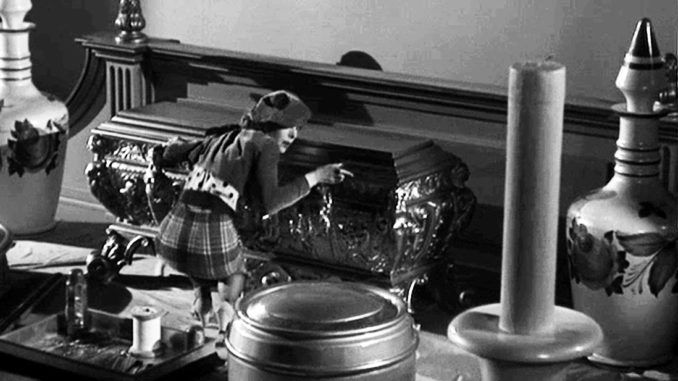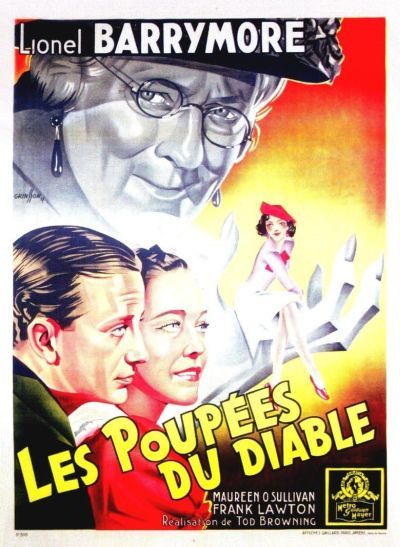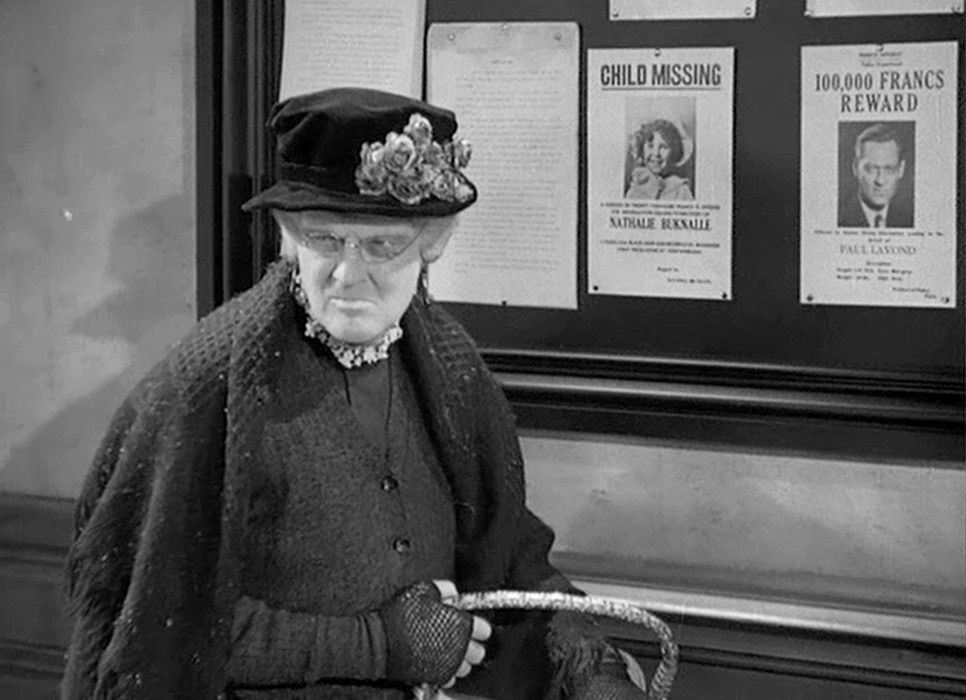
Rating: C+
Dir: Tod Browning
Star: Lionel Barrymore, Maureen O’Sullivan, Frank Lawton, Rafaela Ottiano
This may be almost ninety years old, but MGM are still intent on getting their money back from it. You’d think, given its age (it’ll be formally entering the public domain in less than a decade), it would be up for free on YouTube, or on some of the non-premium streaming services, like Tubi, Roku or Pluto. No such luck. Want to see this one? I guess you’ll need to pay Bezos – since Amazon owns MGM these days – $3.99 for the privilege. Even the Internet Archive, a reliable source of films for this series, is devoid of Devil-Doll. I get that more obscure items, like Song At Midnight, might be hard to track down on the free market. But Browning was probably the best-known director of horror in the thirties.
It certainly won’t be the last time you’ll be seeing him here, although Browning’s more influential work (if not his best), Dracula, was already covered outside this series. He was also responsible for the most sought-after lost film, 1927’s London After Midnight starring Lon Chaney, whose last print was destroyed by an MGM vault fire in the sixties. Tod was originally a sideshow performer, doing a routine called “The Living Hypnotic Corpse”, before becoming an actor, and then a director. While he initially specialized in comedy, a near-fatal car accident caused his work to assume a darker and more melodramatic tone, eventually becoming the doyen of horror in its formative years.
 Devil-Doll is the penultimate film of Browning’s career. He made only Miracles for Sale after this, before being fired by MGM, who were no longer a fan of Tod’s dark view of the world and humanity. Unable to get work elsewhere, the director retired to Malibu Beach and became a virtual recluse. He succumbed to the alcoholism which had been an issue throughout his career (a factor in the accident mentioned above), and lived out the remainder of his life before passing away in 1962. His death came just a month after Freaks had been shown, to a rapturous reception, at the Venice Film Festival. It was part of a re-appraisal of his career, which has since cemented his position as one of horror’s founding fathers.
Devil-Doll is the penultimate film of Browning’s career. He made only Miracles for Sale after this, before being fired by MGM, who were no longer a fan of Tod’s dark view of the world and humanity. Unable to get work elsewhere, the director retired to Malibu Beach and became a virtual recluse. He succumbed to the alcoholism which had been an issue throughout his career (a factor in the accident mentioned above), and lived out the remainder of his life before passing away in 1962. His death came just a month after Freaks had been shown, to a rapturous reception, at the Venice Film Festival. It was part of a re-appraisal of his career, which has since cemented his position as one of horror’s founding fathers.
The Devil-Doll, to be honest, is a minor part of the legacy. It’s a mix of elements that I really liked, with ones which were nowhere near as effective. We begin with the escape from Devil’s Island prison by Paul Lavond (Barrymore) and a scientist called Marcel. Paul was framed for the robbery of his Parisian bank almost twenty years previously; Marcel’s crime is… vague. They make their way to Marcel’s laboratory, where his wife, Malita (Ottiano), has continued his work on miniaturization. They can shrink animals to one-sixth normal size, but the process renders them mindless, only capable of “responding only to the force of another will.” They successfully test it by shrinking an “inbred peasant half-wit” servant, which gives Paul an idea…
For he has been consumed with a desire for revenge on those who got him convicted. The convenient death of Marcel – he basically just drops dead – gives him a chance, convincing Malita to join forces with Paul, and move their operation to Paris, so he can use miniaturized people to wreak vengeance. It also gives Paul a chance to re-connect with his daughter, Lorraine (O’Sullivan). She never knew her father, and blames his bad reputation for her being ostracized by polite society. This whole angle, along with her thoroughly uninteresting fiancé, Toto (Lawton), is not very well-handled, and mostly dull. Though I did like the final scene, where Paul pretends to be a friend of himself, so he can speak to Lorraine about her father.
The other major problem is Paul hiding from the authorities in Paris, by dressing in drag, and pretending to be a granny (below). Visually, it’s tolerable, but the moment he opens his mouth, any illusion of geriatric femininity is shattered, and he sounds more like one of Monty Python’s Pepperpots. Actually, I guess this would be much more plausible nowadays: people would just presume he was trans, and identifying as an old woman. Nobody would dare question that. Here, it feels ridiculous, and I was much more convinced by the insanity of Malita, sporting a Bride of Frankenstein white streak in her hair. She’s perhaps the first female incarnation of the mad scientist; Ottiano, who had been a member of the Théâtre du Grand-Guignol back in Paris, plays it to the hilt.
 I will say, the effects used for the miniaturization are very well-done. When Hollywood went there again over twenty years later, for The Incredible Shrinking Man, the results were hardly improved. You can rarely see the join. That’s because at some point, there isn’t one, such as the giant bedroom set over which one of Paul’s tiny assassins (Grace Ford, top) climbs to complete her mission. These sequences are far more interesting than the banal family drama and unconvincing cross-dressing which dominates the middle of the film. However, I was impressed with Paul, once he’d achieved his goal, pulling the plug on operations: “I never had any plans beyond the vindication of my name”. Not many evil masterminds are prepared to quit while they’re ahead, and Malita’s reluctance to agree with Paul triggers a fiery conclusion.
I will say, the effects used for the miniaturization are very well-done. When Hollywood went there again over twenty years later, for The Incredible Shrinking Man, the results were hardly improved. You can rarely see the join. That’s because at some point, there isn’t one, such as the giant bedroom set over which one of Paul’s tiny assassins (Grace Ford, top) climbs to complete her mission. These sequences are far more interesting than the banal family drama and unconvincing cross-dressing which dominates the middle of the film. However, I was impressed with Paul, once he’d achieved his goal, pulling the plug on operations: “I never had any plans beyond the vindication of my name”. Not many evil masterminds are prepared to quit while they’re ahead, and Malita’s reluctance to agree with Paul triggers a fiery conclusion.
It all makes for a distinctly mixed bag, with some wild swings from the surprisingly effective, to the banal, and on to the ludicrous (mostly Granny Barrymore). I note that in the original source, A Merritt’s novel, Burn Witch Burn, the little people were of occult origin. Perhaps the change to a science-based explanation (I’ve heard this was the suggestion of Erich von Stroheim) was to avoid the wrath of censors. I would suggest it’s ripe for a remake, but I feel Charles Band has already strip-mined this particular seam of miniature horror to within an inch of its life.
This article is part of our October 2025 feature, 31 Days of Vintage Horror.
